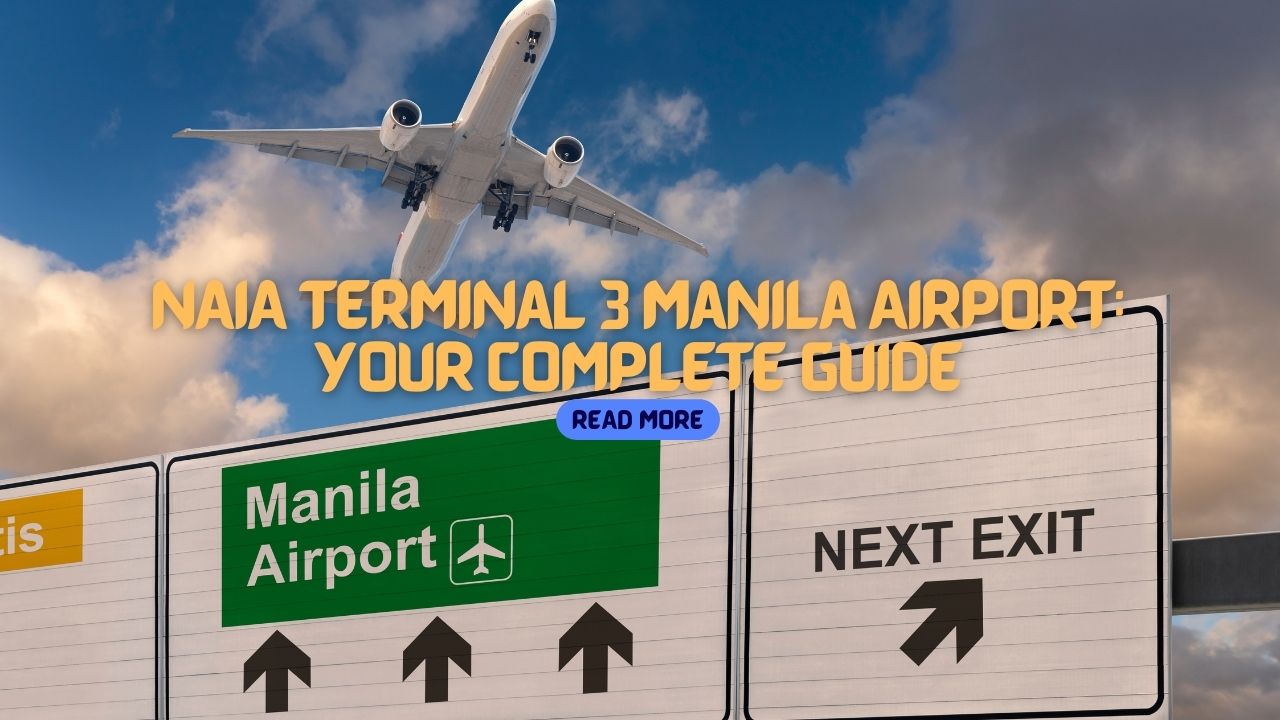Ninoy Aquino Airport Terminal 3: Every part You Must Know
Manila Airport Terminal 3, also often called NAIA Terminal 3 or Ninoy Aquino Airport Terminal 3, is certainly one of the 4 terminals of the Manila International Airport. It’s the latest and most up-to-date terminal, opened in 2008, and is situated in Pasay City, Metro Manila. The terminal has the capability to handle about 13 million passengers per 12 months and is designed to supply a cushty and convenient travel experience.
NAIA Terminal 3 is the principal hub for several airlines, including Cebu Pacific, Philippine Airlines, and AirAsia Philippines. It hosts each international and domestic flights, making it a preferred alternative for travelers. The terminal has 24 gates and 140 check-in counters, making it efficient for passengers to maneuver out and in of the airport.
Passengers arriving at NAIA Terminal 3 can expect a spread of amenities, including shops, restaurants, and lounges. The terminal can be connected to Newport City via a 0.22-kilometer long footbridge, providing quick access to nearby hotels and resorts.
Overview of NAIA Terminal 3
NAIA Terminal 3, also often called Ninoy Aquino International Airport Terminal 3, has 4 levels and a parking garage. The bottom floor is devoted to arrivals, where passengers can find facilities akin to baggage claim and customs. The third level is for departures, with 600 meters of curbside space for efficient drop-offs and pickups.
NAIA Terminal 3 is a two-tiered design, with the bottom floor handling arrivals and the third level facilitating departures. The terminal has 24 gates and 140 check-in counters, ensuring a smooth and hassle-free experience for passengers.
One among the unique features of NAIA Terminal 3 is its footbridge that connects to Newport City, making luxury hotels and entertainment complexes more accessible. The terminal can be equipped with transfer transit facilities, situated within the arrivals level.
NAIA Terminal 3 is a contemporary and efficient airport terminal that gives a cushty and convenient experience for passengers traveling to and from Manila.

Airlines Operating at Terminal 3
Terminal 3 of Manila International Airport is a hub for domestic and international airlines. Below is an inventory of the airlines operating at Terminal 3, categorized by their destination.
International Airlines
- Cathay Pacific is a Hong Kong-based airline that operates flights to and from Hong Kong.
- Singapore Airlines: A flag carrier airline of Singapore that operates flights to and from Singapore.
- All Nippon Airways: A Japanese airline that operates flights to and from Tokyo.
- China Southern Airlines: A Chinese airline that operates flights to and from Guangzhou.
- Emirates: A Dubai-based airline that operates flights to and from Dubai.
- Ethiopian Airlines: An Ethiopian airline that operates flights to and from Addis Ababa.
- Gulf Air: A Bahrain-based airline that operates flights to and from Bahrain.
- Jeju Air: A South Korean airline that operates flights to and from Seoul.
- KLM: A Dutch airline that operates flights to and from Amsterdam.
- Qantas: An Australian airline that operates flights to and from Sydney.
- Qatar Airways: A Qatar-based airline that operates flights to and from Doha.
- Scoot: A Singaporean airline that operates flights to and from Singapore.
- Starlux: A Taiwanese airline that operates flights to and from Taipei-Taoyuan.
- Thai Airways: A Thai airline that operates flights to and from Bangkok-Suvarnabhumi.
- Turkish Airlines: A Turkish airline that operates flights to and from Istanbul.
- United Airlines: An American airline that operates flights to and from Guam and Koror.
Domestic Airlines
- Cebu Pacific domestic and international flights
Note that this list will not be exhaustive and is subject to alter. It is suggested to envision with the airline or the airport for the latest information regarding flight schedules and destinations.
Departures and Arrivals
NAIA Terminal 3 is certainly one of the busiest airports within the Philippines, serving each domestic and international flights. The airport has two levels, the Departures level and the Arrivals level, each with its own set of procedures and facilities.
Check-In Procedures
Check-in procedures at NAIA Terminal 3 are straightforward. Passengers are advised to reach on the airport at the least two hours before their scheduled departure time for domestic flights, and three hours for international flights. They need to proceed to the check-in counters to get their boarding passes and have their luggage checked in. Passengers are required to present their valid identification documents and travel documents, akin to passports and visas, on the check-in counter.
Security Check
After check-in, passengers proceed to the safety check area, where they’re required to go through metal detectors and have their carry-on luggage scanned. Passengers are advised to remove all metal objects, including belts, watches, and jewellery, before passing through the metal detectors. Liquids, gels, and aerosols in containers larger than 100ml are usually not allowed in carry-on luggage and ought to be packed in checked luggage.
Boarding Gates
Boarding gates are situated on the Departures level of NAIA Terminal 3. Passengers should check their boarding passes for his or her assigned boarding gate and proceed to the suitable gate. Boarding gates often open 45 minutes before the scheduled departure time for domestic flights and one hour before for international flights. Passengers are advised to be on the boarding gate at the least half-hour before the scheduled departure time.
Baggage Claim
Upon arrival at NAIA Terminal 3, passengers proceed to the Baggage Claim area on the Arrivals level to gather their checked luggage. Baggage claim carousels are situated within the Baggage Claim area, and the carousel number is displayed on the flight information display screens. Passengers should check the carousel number for his or her flight and wait for his or her luggage to reach.
Customs
After collecting their luggage, passengers proceed to the Customs area, where they’re required to declare any items they’re bringing into the country. Passengers are advised to have their travel documents and customs declaration forms ready for inspection. Prohibited items, akin to illegal drugs and counterfeit goods, are usually not allowed within the country and shouldn’t be brought into the airport.
Facilities and Services
Food and Dining
The terminal has a wide variety of food and dining options, starting from fast food chains to sit-down restaurants. Passengers can grab a fast bite at popular chains akin to McDonald’s, Jollibee, and KFC, or go for more upscale dining at restaurants like Mesa and S&R Latest York Style Pizza. There are also coffee shops akin to Starbucks and The Coffee Bean & Tea Leaf for many who need a caffeine fix.
Shopping and Duty Free
NAIA Terminal 3 has a spread of retailers and duty-free stores for passengers to buy souvenirs, gifts, and other items. Passengers can find luxury brands akin to Coach, Longchamp, and Michael Kors on the Duty-Free Philippines, in addition to local products on the Kultura Filipino store. There are also convenience stores akin to 7-Eleven and Family Mart for last-minute purchases.
Lounges and Rest
For passengers who wish to chill out before their flight, there are lounges and leisure areas available. The Wings Transit Lounge offers comfortable seating, showers, and a buffet spread for passengers to enjoy. There are also massage chairs available for a fee, in addition to a spa and wellness center for many who wish to bask in a full-body massage.
Currency Exchange and ATMs
Passengers can exchange their currency at various exchange booths situated throughout the terminal. There are also multiple ATMs available for many who have to withdraw money. It is suggested to exchange currency before going through security to avoid long lines.
Prayer Rooms and Smoking Areas
NAIA Terminal 3 has prayer rooms available for passengers of various religions. There are also smoking areas situated outside the terminal for many who have to smoke before their flight. Smoking shouldn’t be allowed contained in the terminal.
Transportation and Connectivity
NAIA Terminal 3 is situated in Pasay City and is accessible via several modes of transportation. From taxis to public transportation, attending to and from the airport is straightforward and convenient.
Taxis and Automobile Rentals
Taxis and automobile rentals can be found at NAIA Terminal 3. The airport has an official taxi service, which is protected and reliable. Passengers can even opt to make use of ride-hailing services akin to Grab. Automobile rental services are also available for many who prefer to drive themselves.
Public Transportation
For those on a budget, public transportation is an amazing option. The NAIA Expressway provides a direct link to the airport from Makati and other parts of Metro Manila. Point-to-point buses, that are air-conditioned and comfy, are also available.
Inter-Terminal Transportation
For passengers who have to transfer between terminals, there may be a free shuttle bus available. The UBE Express shuttle bus operates 24/7 and stops at NAIA Terminal 1, Terminal 2, Terminal 3, and Terminal 4. The shuttle bus is situated on the buses area.
Terminal Layout and Navigation
NAIA Terminal 3 is a contemporary and spacious airport terminal, covering an area of 182,500 square meters. The terminal has 4 levels, including the Ground Floor, Arrivals Level, Mezzanine Level, and Industrial Area. Each level has its own unique features and functions.
Ground Floor
The Ground Floor of NAIA Terminal 3 is where passengers can find the airport’s transportation options, including taxi stands, shuttle buses, and automobile rental services. The airport’s parking garage can be situated on this level. Passengers arriving on the airport can proceed to the Arrivals Level via escalators or elevators situated on the Ground Floor.
Arrivals Level
The Arrivals Level of NAIA Terminal 3 is where passengers can find baggage claim and customs facilities. The transfer transit facilities are also situated on this level. Passengers can access the Mezzanine Level via escalators or elevators situated on the Arrivals Level.
Mezzanine Level
The Mezzanine Level of NAIA Terminal 3 is where passengers can find a wide range of shops, restaurants, and other industrial establishments. The extent also contains a medical station, transfer transit point, ATMs, phone booths, restrooms, help desk, amongst others. Passengers can access the Industrial Area via escalators or elevators situated on the Mezzanine Level.
Industrial Area
The Industrial Area of NAIA Terminal 3 is where passengers can discover a wide selection of shopping and dining options. The realm contains a number of stores, including duty-free shops, souvenir shops, and fashion boutiques. Passengers can even find a wide range of restaurants and cafes offering a various number of international and native cuisine.
Additional Information
Free Wi-Fi and Connectivity
NAIA Terminal 3 offers free Wi-Fi connectivity to all its passengers. The Wi-Fi network might be accessed by connecting to the “NAIA FREE WIFI” network. Passengers can enjoy unlimited browsing and downloads with none deadline. Nevertheless, the Wi-Fi speed might be slow during peak hours as a consequence of congestion.
Transfer Between Terminals
Transferring between terminals generally is a hassle at Manila International Airport. Passengers can transfer between terminals through the airport shuttle service, which is offered at no cost. The shuttle service runs 24/7, and the travel time between terminals is around 20 minutes. Passengers can even use the airport taxi service to transfer between terminals, but this comes at a further cost.
Airport Congestion and Delays
NAIA Terminal 3 is understood to experience congestion and delays as a consequence of the high volume of passengers it handles. Passengers are advised to reach on the airport at the least three hours before their flight to avoid any inconvenience. Delays can occur as a consequence of various reasons, akin to weather conditions, air traffic control, or technical issues. Passengers are advised to maintain themselves updated with the newest flight information by checking the airport’s website or contacting their airline.

Steadily Asked Questions
Which airlines operate from Terminal 3 at Ninoy Aquino International Airport?
NAIA Terminal 3 serves each domestic and international airlines. A number of the airlines operating from Terminal 3 include Air Asia, Cathay Pacific, Cebu Pacific, Emirates, and Etihad Airways. Passengers are advised to envision with their respective airlines for the newest flight schedules and knowledge.
How can passengers check the status of a flight departing from or arriving at Terminal 3?
Passengers can check the status of their flights departing from or arriving at NAIA Terminal 3 by visiting the official website of Manila International Airport Authority (MIAA) or by contacting their respective airlines. The MIAA website provides real-time information on flight schedules, arrivals, and departures.
What facilities can be found within the departure area of NAIA Terminal 3?
The departure area of NAIA Terminal 3 has a spread of facilities to cater to the needs of passengers. A number of the facilities available include restaurants, cafes, duty-free shops, lounges, ATMs, and currency exchange counters. Moreover, there are also facilities for disabled passengers, including wheelchair access and special assistance.
Are you able to provide information on the domestic services at NAIA Terminal 3?
NAIA Terminal 3 offers a spread of domestic services, including flights to varied destinations throughout the Philippines. Domestic passengers can check-in on the dedicated counters situated on the third floor of the terminal. The departure gates for domestic flights are situated on the fourth floor of the terminal.
What are the fees for the terminal fee at NAIA Terminal 3, and the way is it paid?
Passengers departing from NAIA Terminal 3 are required to pay a terminal fee of PHP 550 for international flights and PHP 200 for domestic flights. The fee might be paid on the terminal fee counters situated within the departure area of the terminal. Payment might be made in money or by bank card.
How can travelers find their departure gate at NAIA Terminal 3?
Passengers can find their departure gate at NAIA Terminal 3 by checking the flight information display screens throughout the terminal. The screens provide real-time information on flight schedules, arrivals, and departures. Passengers can even ask for assistance from the airport staff or their respective airlines.
Like, Follow, and Subscribe to OutofTownBlog.com on Facebook, Twitter, Instagram, Pinterest, and Team Out Of Town on YouTube for more updates.
Help us improve this text about NAIA Terminal 3 International Airport by sending suggestions and posting a comment below.
Read:
Unlock the world’s wonders with unforgettable journeys tailored just for you! Whether you crave sun-kissed beaches, thrilling adventures, or rich cultural escapes, your dream destination awaits. Enjoy seamless travel with expert tips, exclusive deals, and handpicked experiences that Turn Every Trip into a lifetime memory.










